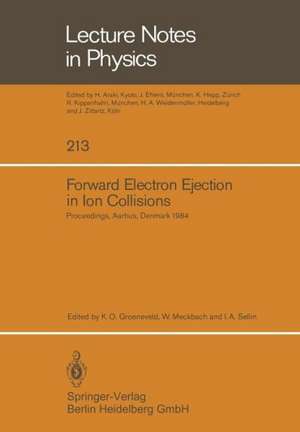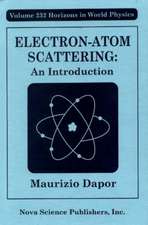Forward Electron Ejection in Ion Collisions: Proceedings of a Symposium Held at the Physics Institute, University of Aarhus, Aarhus, Denmark, June 29–30, 1984: Lecture Notes in Physics, cartea 213
Editat de K. O. Groeneveld, W. Meckbach, I. A. Sellinen Limba Engleză Paperback – noi 1984
Din seria Lecture Notes in Physics
- 19%
 Preț: 424.00 lei
Preț: 424.00 lei - 17%
 Preț: 360.73 lei
Preț: 360.73 lei -
 Preț: 429.22 lei
Preț: 429.22 lei - 17%
 Preț: 427.62 lei
Preț: 427.62 lei - 17%
 Preț: 460.26 lei
Preț: 460.26 lei -
 Preț: 427.96 lei
Preț: 427.96 lei -
 Preț: 481.93 lei
Preț: 481.93 lei - 17%
 Preț: 494.66 lei
Preț: 494.66 lei -
 Preț: 281.90 lei
Preț: 281.90 lei - 17%
 Preț: 493.20 lei
Preț: 493.20 lei - 17%
 Preț: 426.72 lei
Preț: 426.72 lei -
 Preț: 365.15 lei
Preț: 365.15 lei -
 Preț: 374.52 lei
Preț: 374.52 lei -
 Preț: 407.98 lei
Preț: 407.98 lei - 20%
 Preț: 428.13 lei
Preț: 428.13 lei -
 Preț: 263.30 lei
Preț: 263.30 lei - 15%
 Preț: 593.73 lei
Preț: 593.73 lei - 15%
 Preț: 528.13 lei
Preț: 528.13 lei -
 Preț: 493.12 lei
Preț: 493.12 lei - 17%
 Preț: 425.68 lei
Preț: 425.68 lei -
 Preț: 280.65 lei
Preț: 280.65 lei -
 Preț: 163.41 lei
Preț: 163.41 lei - 18%
 Preț: 726.59 lei
Preț: 726.59 lei -
 Preț: 394.84 lei
Preț: 394.84 lei - 15%
 Preț: 709.63 lei
Preț: 709.63 lei - 15%
 Preț: 623.90 lei
Preț: 623.90 lei - 20%
 Preț: 476.93 lei
Preț: 476.93 lei - 15%
 Preț: 428.05 lei
Preț: 428.05 lei -
 Preț: 342.78 lei
Preț: 342.78 lei - 18%
 Preț: 851.93 lei
Preț: 851.93 lei -
 Preț: 346.61 lei
Preț: 346.61 lei -
 Preț: 391.57 lei
Preț: 391.57 lei - 15%
 Preț: 633.16 lei
Preț: 633.16 lei -
 Preț: 451.71 lei
Preț: 451.71 lei - 5%
 Preț: 1497.80 lei
Preț: 1497.80 lei -
 Preț: 374.85 lei
Preț: 374.85 lei -
 Preț: 380.07 lei
Preț: 380.07 lei - 15%
 Preț: 516.14 lei
Preț: 516.14 lei - 15%
 Preț: 583.78 lei
Preț: 583.78 lei - 15%
 Preț: 508.60 lei
Preț: 508.60 lei -
 Preț: 469.73 lei
Preț: 469.73 lei -
 Preț: 388.90 lei
Preț: 388.90 lei - 15%
 Preț: 500.24 lei
Preț: 500.24 lei -
 Preț: 386.52 lei
Preț: 386.52 lei - 15%
 Preț: 472.88 lei
Preț: 472.88 lei -
 Preț: 424.27 lei
Preț: 424.27 lei -
 Preț: 380.07 lei
Preț: 380.07 lei - 15%
 Preț: 500.01 lei
Preț: 500.01 lei
Preț: 382.95 lei
Nou
Puncte Express: 574
Preț estimativ în valută:
73.30€ • 79.65$ • 61.61£
73.30€ • 79.65$ • 61.61£
Carte tipărită la comandă
Livrare economică 21 aprilie-05 mai
Preluare comenzi: 021 569.72.76
Specificații
ISBN-13: 9783540138877
ISBN-10: 3540138870
Pagini: 180
Ilustrații: VII, 168 p. 3 illus.
Dimensiuni: 170 x 244 x 9 mm
Greutate: 0.3 kg
Ediția:1984
Editura: Springer Berlin, Heidelberg
Colecția Springer
Seria Lecture Notes in Physics
Locul publicării:Berlin, Heidelberg, Germany
ISBN-10: 3540138870
Pagini: 180
Ilustrații: VII, 168 p. 3 illus.
Dimensiuni: 170 x 244 x 9 mm
Greutate: 0.3 kg
Ediția:1984
Editura: Springer Berlin, Heidelberg
Colecția Springer
Seria Lecture Notes in Physics
Locul publicării:Berlin, Heidelberg, Germany
Public țintă
ResearchCuprins
Electron loss to the continuum for light ions.- Theoretical description of the cusp electrons ejected in asymmetric heavy-ion collisions.- Double differential cross section for electron capture to the continuum with molecular projectiles.- Density matrix description of collisional electron transfer into the continuum of ionic projectiles.- A time dependent secondary electron transport model.- Continuum-electron capture by 25-250-keV protons in helium.- The influence of a diffuse target on electron loss into the continuum double differential distributions.- CUSP studies for simple collision systems.- Doubly differential emission distributions for electron loss to the continuum from fast heavy projectiles in gas targets.- Projectile continuum electrons in highly charged ion-atom collisions.- L-shell vacancy production by electron capture to projectile-centered continuum states (ECC) in proton-argon collisions.- Electron capture into metastable Kr8+ recoil ions.- Three dimensional convoy electron velocity distributions produced by 60–270 keV proton impact on carbon foils.- Anomalous mean free paths for scattering of convoy electrons generated by fast, highly ionized ions in thin solid targets.- Rydberg-state production in collisions between fast ions and carbon targets.- Convoy electrons from atomic and molecular heavy ion collisions with solids.- Alignment of high rydberg states in hydrogen.














